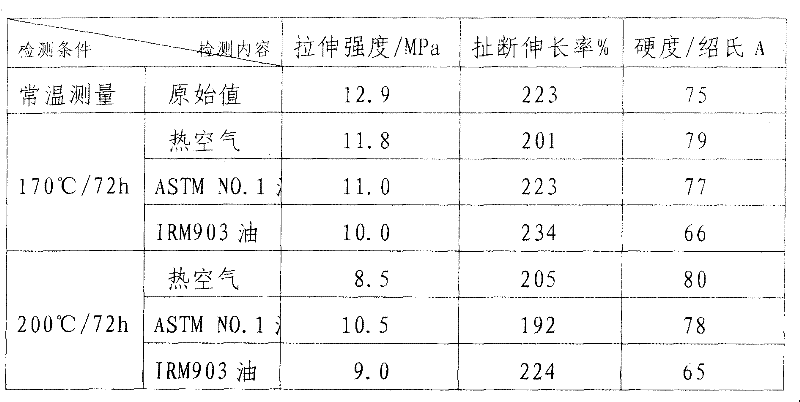Preparation method of durable ultrahigh temperature resisting acrylic rubber
A polyacrylate and acrylate technology, which is used in the preparation of durable and ultra-high temperature-resistant polyacrylate rubber, can solve the problems of few types of silicon-containing or fluorine-containing monomers, uneconomical, high price, and avoid side effects. The effect of reaction, increase of average molecular weight and strong penetration
- Summary
- Abstract
- Description
- Claims
- Application Information
AI Technical Summary
Benefits of technology
Problems solved by technology
Method used
Image
Examples
Embodiment 1
[0017] Example 1. 10 parts of methyl acrylate, 75 parts of ethyl acrylate, 10 parts of isooctyl acrylate, 5 parts of vinyl chloroacetate, 180 parts of deionized water, 3 parts of sodium lauryl sulfate, and 102 parts of OP-10.
[0018] First, add sodium lauryl sulfate, OP-10 and deionized water into the emulsification tank and stir to dissolve; then mix the acrylate monomer, low-temperature monomer, and vulcanization point monomer into the emulsification tank. Emulsify at high speed for 20 minutes. Transfer the emulsified emulsion to the reactor, 60 The Co high-energy ray initiates polymerization, the reaction temperature is controlled at 40°C-50°C, and the total absorbed dose reaches 30kGy to complete the reaction. At this time, the polyacrylate emulsion has been prepared. Under the condition of 80°C, add the polyacrylic acid emulsion into the alum solution with a mass percentage of 5% to break the emulsion, stir while adding the emulsion, and wait until the emulsion is comp...
Embodiment 2
[0025] Example 2. 10 parts of methyl acrylate, 60 parts of ethyl acrylate, 25 parts of butyl acrylate, 5 parts of vinyl chloroacetate, 200 parts of deionized water, 3 parts of sodium lauryl sulfate, 102 parts of OP-10. Use the method of embodiment 1 to make acrylate raw rubber.
[0026] 100 parts of raw rubber, 60 parts of N5506, 10 parts of kaolin, 1.5 parts of stearic acid, 2 parts of antioxidant 445, 1.5 parts of TCY, 3 parts of BZ, 2 parts of microcrystalline wax, 5 parts of RS107. Use the method of embodiment 1 to make rubber product.
[0027] In addition to the general advantages of the product in Example 1 above, the rubber product of this example also has good mechanical processing performance, has small volume expansion after long-term immersion in oil, and can still be used normally at -20°C.
Embodiment 3
[0028]Example 3. 7 parts of methyl acrylate, 70 parts of ethyl acrylate, 20 parts of butyl acrylate, 2 parts of acrylic acid, 2 parts of methacrylic acid, 180 parts of deionized water, 3 parts of sodium lauryl sulfate, 102 parts of OP-10. Use the method of embodiment 1 to make acrylate raw rubber.
[0029] 100 parts of raw rubber, 15 parts of N330, 50 parts of N550, 10 parts of graphite powder, 1.5 parts of stearic acid, 2 parts of antioxidant 445, 1.5 parts of DOTG, 1 part of Diak No.1 curing agent, 2 parts of microcrystalline wax copies, NB-45 copies. Use the method of embodiment 1 to make rubber product.
[0030] As automotive oil seals and transformer oil seals, the material in this embodiment can be used for a long time at 180°C.
PUM
 Login to View More
Login to View More Abstract
Description
Claims
Application Information
 Login to View More
Login to View More - R&D
- Intellectual Property
- Life Sciences
- Materials
- Tech Scout
- Unparalleled Data Quality
- Higher Quality Content
- 60% Fewer Hallucinations
Browse by: Latest US Patents, China's latest patents, Technical Efficacy Thesaurus, Application Domain, Technology Topic, Popular Technical Reports.
© 2025 PatSnap. All rights reserved.Legal|Privacy policy|Modern Slavery Act Transparency Statement|Sitemap|About US| Contact US: help@patsnap.com

